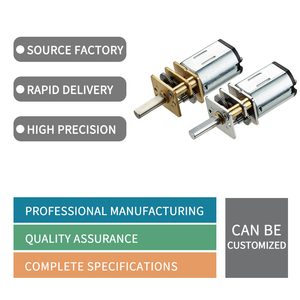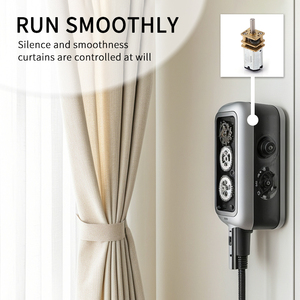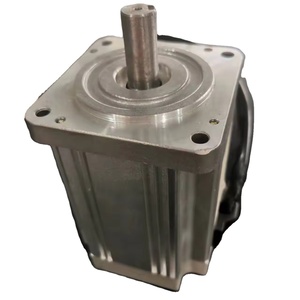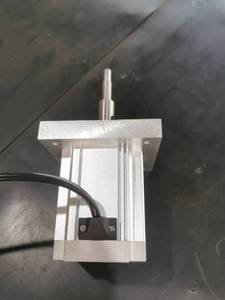
All categories
Featured selections
Trade Assurance
Buyer Central
Help Center
Get the app
Become a supplier

(8843 products available)








































There are several types of simple dc motors, each with its own characteristics and applications.
Brushed dcmotors have been widely used for many years. They consist of an armature, commutator, brushes, and a permanent magnet or field coil system. The brushes make contact with the commutator segments, allowing the current to flow through the armature coils. This generates a magnetic field that interacts with the motor's static magnetic field, resulting in torque and rotation.
In contrast, brushlessdcmotors eliminate brushes and commutators. Instead, they use electronic controllers to switch the current between different motor parts. This increases efficiency, reduces maintenance needs, and produces less heat and friction.
Coreless dc motors are designed without the iron core in the armature found in typical brushed DC motors. Instead, the wire coil is arranged in a lightweight, cubic structure. This design decreases the motor's mass while increasing its power generation capacity. Coreless dc motors are suitable for small, compact devices requiring quick response and reliable performance.
These motors combine a brushed or brushless DC motor with a planetary gearbox. It reduces motor speed while upping torque. This combination allows for high torque and precise speed control in one unit with efficiency. These motors are commonly used in robotics, automation, and vehicles.
This section will explore the durability of a: simple dc motor
Stator Materials
The stator of a brushed dcmotor can be made of either permanent magnets or field coils. Common materials for permanent magnets include neodymium, ferrite, or samarium-cobalt. These ensure the magnet generates a strong, stable magnetic field. If wound field coils are used, they are often constructed from copper wire due to its high conductivity.
Armature Materials
The armature or rotor is typically made from silicon steel. This retains and concentrates magnetic flux to improve motor efficiency. The armature winding is often made from copper wire to decrease electrical resistance and promote current flow.
Commutator and Brushes
Brushed DC motors feature commutators made of copper segments insulated by mica. Mica is chosen for its heat and electrical insulation properties. The commutator's material needs to be conductive, as it transfers electricity between the armature and the external circuit. Brushes are often constructed from carbon or graphite. These reduce friction, wear, and electrical resistance when transferring current to the commutator.
Housing and Bearings
The motor housing protects internal components from dirt, debris, and physical damage. It is commonly made from durable materials like steel or aluminum. This also provides structural support. For sealed motors, additional protective materials like rubber or silicone may be used to form a waterproof seal. Bearings lubricated with grease or oil help maintain smooth rotation and reduce wear.
Wear and Tear
Over time, commutator wear can lead to decreased performance if not maintained properly. Regular maintenance and use of quality components help minimize wear and extend motor life.
Heat Resistance
Electric currents generate heat within the motor. Be it from armature winding resistance or mechanical friction. Excessive heat can damage components, including insulation, brushes, and commutator. Good ventilation, heat sinks, and using heat-resistant materials are crucial for preventing motor damage in high-heat environments.
Environmental Sealing
Dust, moisture, and debris can enter unsealed motors and damage bearings, brushes, or other components. Those who operate in harsh environments should install protective materials like rubber seals or dust covers on motors. regularly clean and inspect their motors for signs of damage or wear caused by environmental factors.
Electrical Insulation
Over time, electrical insulation can degrade, leading to short circuits or decreased motor efficiency. High-quality insulation materials on the armature, commutator, and other areas are crucial for preventing electrical failures. Insulated bearings can also prevent contamination by lubricants.
Simple DC motors have significant commercial value, driving innovation and efficiency in multiple industries. These motors' adaptability, compact size, ease of control, and cost-effectiveness make them a desirable option in many fields. Below is a look at various sectors where electric dc motors find significant application.
Simply dc motors are widely used in automobiles today. They help power different systems, such as power windows, seats, and mirror adjustments. Brushless DC motors are also common in car HVAC (heating, ventilation, and air conditioning) systems and electric vehicle components. Here, they help drive fans and cooling systems.
Home appliances like vacuum cleaners, washing machines, and portable hairdryers use DC motors. They provide the necessary speed control and torque for different motor functions. Fans in laptops, computers, and other cooling electronic devices use these motors to ensure proper ventilation.
Simple DC motors drive conveyor belts, pumps, and other machinery in industrial settings. The brushed version of these motors offers high torque at low speeds. This makes them suitable for heavy loads in manufacturing and warehouse automation. Moreover, geared dc motors serve as important tools in robotic arms and pick-and-place machines in the automation industry.
The medical space also uses DC motors in various devices such as surgical tools, wheelchair actuators, and infusion pumps. Brushless DC motors are favored here due to their quiet operations, durability, and precise speed control. This makes them ideal for operating devices requiring accuracy and reliability.
Aerospace and defense applications require motors that can withstand extreme conditions. DC motors are used here in navigation systems, actuators, and miniaturized drones. They are also commonly installed in remote-controlled vehicles and equipment that operate in hostile environments.
In renewable energy, brushed and brushless DC motors are common. They help generate electricity from wind turbines and other kinetic energy sources. They also help with battery charging systems, where these motors provide efficient control over energy transfer for sustainable power solutions.
This section will detail how to select a: simple dc motor.
Load and Torque Requirements
These are usually measured in Newton-meters or ounce-inches. The torque requirement must equal or exceed the rated torque of the DC motor selected. Assess the maximum load and type the motor will drive. Assess whether it will be a dynamic or static load to determine the required torque. Know that dynamic loads will need higher torque values to operate than static ones.
Speed and RPM
The RPM range of a dc motor indicates its rotational-speed capability. Choose a motor with the proper RPM range for the application. This depends on the desired speed of the equipment the motor will power. The motor should be able to maintain the required speed at its load torque. The motor should also be able to handle its peak torque if the load demands maximum torque intermittently.
Power Supply and Voltage
Simple dcmotors are available in various voltage ratings. These include 6V, 12V, and 24V. Choosing the right voltage ensures proper motor performance. Know which power supply the motor will connect to. A compatible motor will have less electrical efficiency and safety risk.
Control Method
The first thing to consider here is what the control method of the motor will be. DC motors with variable-speed or direction control typically have either PWM or voltage control. This will help modulate speed and torque effectively based on load. PWM helps improve efficiency and reduce heat during motor operations.
Mechanical Features
Factors like the motor frame size, mounting configurations, and shaft type determine how compatible the motor is in the existing system. Also, consider the motor housing material. This will ensure the motor can withstand harsh environments. Lastly, check the motor's bearing type. A voluntarily sheltered motor will require less maintenance and have a longer service life.
Mounting the Motor
The first step to the installation is to mount the dc电动 motor securely. This will ensure proper alignment and minimizes vibrations. All other motor components will then connect to this mounting. This includes gears, pulleys, or shafts.
Connecting the Power Supply
The next step is to connect the power supply to the motor terminals. Properly match the motor voltage rating to the power supply voltage. Note that this ensures the motor operates effectively and safely. It also helps prevent electrical overloads or short circuits.
Wiring the Controller
For applications requiring speed or direction control, the next installation step is to wire the controller. That is to say, connect a PWM controller or a voltage controller to regulate motor speed.
Testing the System
Once wired, the installed motor will need a test to ensure proper functionality. All this after the mounting, electrical connections, and initial setup. The testing will help check if the motor rotates in the right direction at its desired speed. It will also help identify any potential issues. After the initial testing, a load test will check the motor's performance under typical operating conditions.
A1: Automotives, home appliances, and industrial equipment commonly use simple DC motors. These motor types are found in medical devices, robotics, and aerospace applications. Lastly, they are also popularly used in renewable energy systems and electronic gadgets.
A2: The two common types are brushed and brushless DC motors. Brushed motors offer simple control of speed and torque. This is ideal for low-power applications. Meanwhile, brushless motors provide higher efficiency and durability. That durability is not for harsh environments.
A3: Dust, heat, and improper electrical insulation are the common factors affecting the durability of DC motors. Regular maintenance of these motors also helps minimize wear and tear. Moreover, proper environmental sealing of the motor reduces debris and moisture entry. This prevents damage to internal components.
A4: Use the right power supply voltage and employ electrical insulation of the bearings. proper ventilation will also help mitigate excessive heat. Motor cooling and heat sinks are also effective methods to reduce heat during operations.
A5: The stator is usually composed of ferrite, samarium-cobalt, or silicon steel. The common metals used for the commutator's brushes are copper and carbon. These are favored because copper offers low resistance, while carbon helps reduce friction and wear.